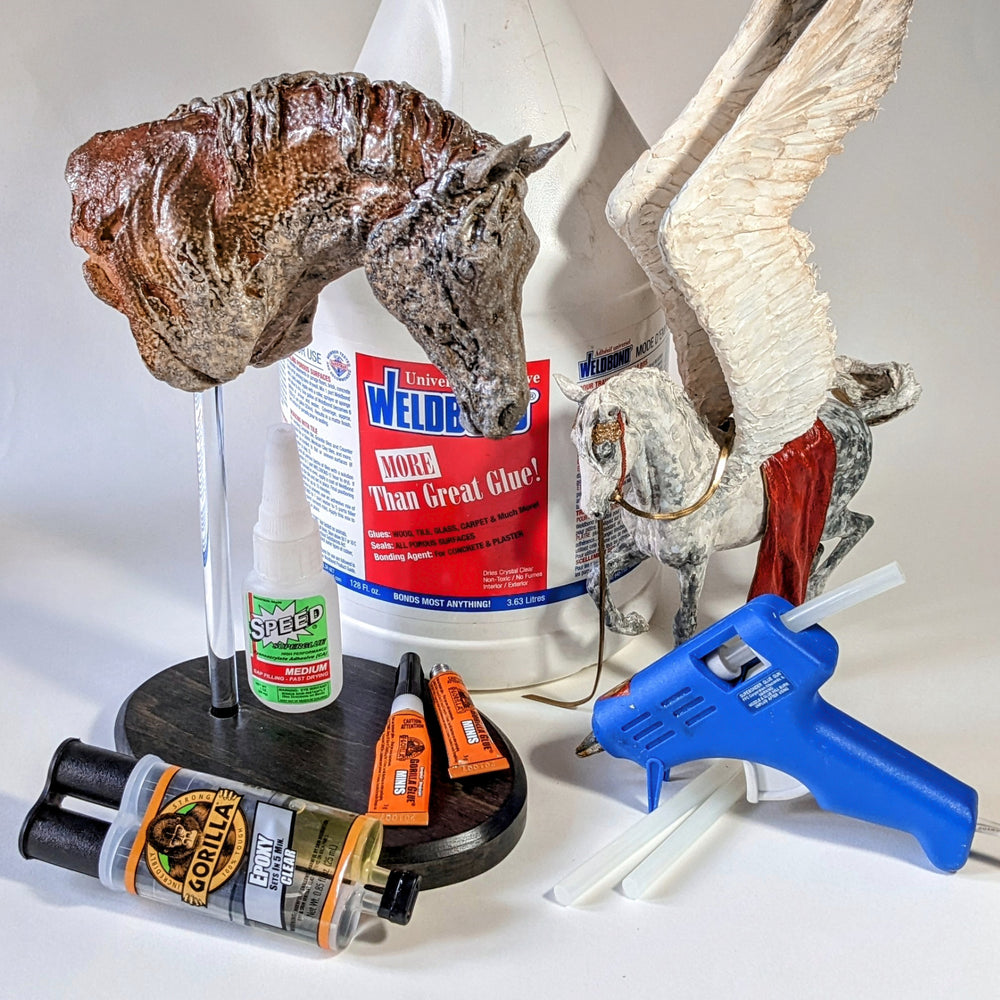
Disclosure: This post contains some affiliate links. I may earn a small commission at no extra cost to you, supporting my blog and content creation. Thank you!
---
Glue plays an essential role in the world of air dry clay and ceramic sculpting. Whether you're attaching a tail or fixing a break, it's crucial to choose the right glue for the task. In this blog post, we'll explore the various glues I use in my work, their strengths, and their weaknesses. Keep in mind that I'll mention a few brand names, but there may be other equally good or superior products out there. These are simply the ones I currently use.
Safety and Application Considerations: Before diving into the different types of glue, consider these safety and application tips:
- Make sure your glue works well with your specific medium (e.g., hot glue can melt Styrofoam, some glues do not work well with certain plastics).
- Be mindful of off-gassing potential; work in a well-ventilated area.
- Protect work surfaces and clothing from potential glue damage.
The Ooey Gooey Good Stuff

Super Glue (Cyanoacrylate)
Super glue is one of my go-to glues for bonding small pieces like wire mesh for ears or tails. Its quick drying time allows me to continue working within minutes. However, it's best used on small items as it dries quite brittle.
Drying time: less than a minute (depends on viscosity and bond size).
Strengths: Quick drying and strong bond.
Weakness: Dries brittle, not suitable for thick applications, and not clear (usually dries milky white)
Sculptor's tip: You can get differing viscosity of super glue. I prefer medium or gel thickness as I can control where it goes better.
Sculptor's Favourites: Speed Super Glue, which does not seem to be available outside of my local art store. In a pinch, I have also used these two types and they work great (note they are gel viscosity): Loctite Super Glue and Gorilla Super Glue Gel.

2-Part Epoxy Glue
When I don't need an instant bond, I turn to 2-part epoxy glue. It's strong, flexible, and suitable for many applications, such as attaching sculptures to bases. The glue itself is quite thick and is better for applying with a tool rather than pouring.
Drying time: Gentle handling after around 30mins is possible, fully cures in 24hrs.
Strengths: Strong and flexible bond.
Weakness: Requires correct measuring/mixing, may not dry clear (depending on brand), not suitable for all plastics.
Sculptor's Tip: I mix my epoxy glue on an old plastic yogurt container lid for 2 reasons: 1) It can be peeled off once dry and I can reuse the lid, and 2) It has a lip all the way around to prevent the glue from running off.
Sculptor's Favourites: I prefer the syringe type applicators. Some of my go-tos: Gorilla Glue 2-part epoxy and J-B Weld ClearWeld.

Gorilla Glue Original
While Gorilla Glue makes a variety of types of glues, this is referring to the "Original", which is a polyurethane-type glue that expands when drying, making it perfect for filling gaps and bonding items that don't fit tightly.
Drying time: 80% dry in 1-2 hours, fully cures in 24 hours.
Strengths: Strong, flexible bond, expands to fill gaps.
Weakness: Dries amber-colored, may expand beyond glue area and look unsightly.
Sculptor's Tip: The expanding feature can create issues. If you are using it somewhere visible, you must make sure to not use too much glue as it can expand beyond where you apply it as it dries. Luckily, it is often possible to cut away after it's dry if it's in small enough.
Sculptor's Favourites: While you can purchase a single large bottle, I prefer the smaller mini packs as I don't use this glue that often, and this ensures it doesn't dry out.
White Glue
While I rarely use white glue on sculptures themselves, it's handy for odd jobs around the studio.
Strengths: Good flexible bond (strength often depends on the brand)
Weakness: Slow setting, bond needs clamping for strength
Sculptor's Tip: I use white glue to stick foam sheets together for shipping.
Sculptor's Favourites: I am a huge fan of WeldBond. I think it's the strongest white glue I've ever used. Plus it's Canadian (like me) 🍁.
Wood Glue
I include this one here because I have used it a lot in the past for paper mache applications. Wood glue is like white glue on steroids - much stronger, but very similar behaviour.
Strengths: Generally a stronger bond than white glue.
Weakness: Not suitable for plastics, dries amber-colored.
Sculptor's Tip: Diluted with water this is the strongest paper mache mix you will ever experience.
Sculptor's Favourites: I like Titebond III, but it tends to only be sold in gallon containers. Titebond Original is still a good substitute.

Hot Glue
This may recall your childhood craft days, but hot glue does have a place in the sculptor's studio. I use it for building big armatures to hold things in position.
Strengths: Quick bonding for big items.
Weakness: Weak bond, best used for initial hold.
Sculptor's Tip: Make sure you buy glue sticks that match the size of your glue gun. I speak from experience :)
Sculptor's Favourites: No specific brand; I use a cheap, no-name mini glue gun with matching glue sticks that I buy randomly.
Glue It, Sculpt It, Love It!
In conclusion, understanding the various types of glue and their unique properties can elevate your sculpting experience and lead to impressive results. Remember, experimentation is key to finding the perfect glue for your specific needs. By exploring different options and considering the tips provided, you'll be well on your way to creating beautiful and durable air dry clay sculptures.
What's Next?
Discover the Secrets of Sculpting with Creative Paperclay
Get the scoop on wire to make your next armature a success

